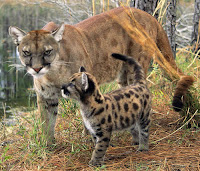Monday, June 8th, 2015
The Florida Panther: A Battle for Survival
Posted by Cody Leventhal
 |
| Photo By U.S. Fish and Wildlife Service |
Brief Overview:
Scientific name: Puma concolor coryi
Other Names: Florida Panther
Range: Southern Florida
Status: Endangered
Listing Date: 1967
Recovery plan Revised: 1981, 1987, 1995, 2008
Ecology of the Florida Panther:
 |
| Photo from Pixshark.com |
Geographic and Population Changes:
In the 1970's, the estimated Florida Panther population had dropped to between 12 and 20 individuals from over-exploitation and habitat loss. After becoming protected by the Endangered Species Act in 1973, conservation efforts have nurtured the estimated population back to between 100-120 individuals in 2007. The First Florida Panther specimen was found in Sebastian, Florida. This being said, it is important to note that the Florida Panther population, because of habitat loss and meta-population extirpation, has now been limited to a habitat that is less than 5% of the size of their previous range. Before extreme human involvement, the Panther's range occupied most of the southeastern U.S. including Mississippi, Alabama and Georgia (as shown in dark blue on the map) but is now limited to a small area of 3,548 square miles in Southern Florida (shown in red on the map) (FWS, 2008).
Cause of Listing and Main Threats:
Before 1949, the Florida Panther could be poached year-round. Panthers were hunted at extremely high rates up until this time as they were perceived as a threat to humans and development. The Florida Panther Act of 1978 made the killing of one of these animals a felony. Growing human populations and developments continue to hinder restoration efforts, though, because they encroach more and more of the Panther's already limited habitat. A lack of genetic diversity due to small population sizes and inbreeding is another factor that exposes panthers to higher risk of genetic defects and disease. Another major threat to the already small Florida Panther population is Motor-vehicle related accidents, which account for about 20% of Panther deaths (Land et al. 2004). Unfortunately the largest threat to Panthers, which accounts for the most Panther deaths every year since 1972, is unpreventable as it is due to intraspecific aggression. Intraspecific aggression accounts for about 42% of Panther mortality and occurs mostly between males in an attempt to show dominance.
The ultimate goal of the U.S. Fish and Wildlife service is to ensure the long term survival of the Florida Panther and restore it to the point where is can be delisted from the Federal List of Endangered and Threatened Species. The qualifications that need to be met for the Panther to be delisted are the existence of three separate, self-sustaining populations of at least 240 individuals that have been maintained for at least 12 years. In order to achieve this, the FWS has listed actions that are essential to achieving the goal. They go as follows:
- Maintain and Expand the Panther population in South Florida.
- Expand the Breeding population North of the Caloosahatchee River.
- Find potential reintroduction points within the Panther's historic range
- Reintroduce viable panther populations outside of Southern Florida
- Secure and maintain habitat in reintroduction areas
- Facilitate recovery through increased public awareness and education (FWS, 2008)
If these actions are followed through with, and the Florida Panther population and habitat is expanded and secured, it is very possible that the Florida Panther could be delisted from the Federal List of Endangered and Threatened species within 75 years! That means that this magnificent and majestic cat could be restored within many reader's lifetime!



No comments:
Post a Comment